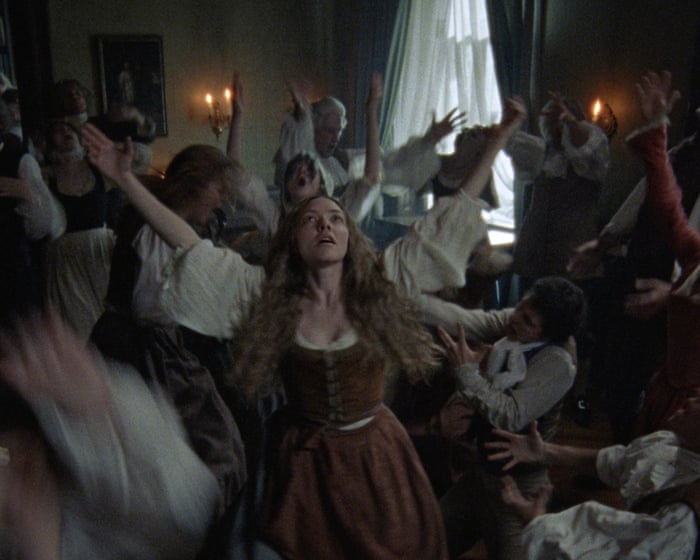“Our ordeal is worth it!” This cry comes from one of the faithful in Mona Fastvold’s film, which she co-wrote with her partner Brady Corbet—the same duo behind The Brutalist. It’s a passionate, intense, and visually striking drama, though at times bewildering, centered on the historical figure of Ann Lee. As the leader of the fundamentalist Shaker movement, Lee faced religious persecution in 18th-century England.
Believed to embody Christ’s second coming, Lee brought her radical teachings to the New World, where she established a lasting spiritual community in pre-revolutionary America. There, she and her followers faced renewed persecution—this time for her identity as a woman and a pacifist. The Shakers became known for their elegantly minimalist furniture, though the film doesn’t emphasize any connection to Christ’s work as a carpenter.
Amanda Seyfried plays Lee, with Lewis Pullman as her brother William and Christopher Abbott as her oppressive husband Abraham, who appears to enjoy a form of Christian-themed dominance in their marital relationship.
The film shifts in tone: at times, it resembles a Lars von Trier-esque nightmare of ironic martyrdom or a Robert Eggers-style horror like The Witch; at others, it plays like a strange but spectacular Broadway musical, where the ecstatic trembling of the worshippers—surrendering to divine joy—is choreographed almost like the percussive energy of Stomp. Atheists and rationalists in the audience may find themselves wondering: What exactly is Ann Lee’s testament? What message or legacy does she offer the 21st century?
The answer seems to be simply that she founded a Christian sect—a fact underscored by statistics shown during the closing credits. Lee fervently believed all sex was sinful, a distraction from spiritual devotion. The film doesn’t address how, if everyone abstained, humanity would avoid extinction. Are outsiders expected to perpetuate the species through their “deplorable” activities so that children can later be brought into the faith? To modern viewers, the shaking, trembling, and speaking in tongues may look like collective hysteria or sexual repression—yet the film stops short of endorsing that interpretation, asking us instead to take Lee seriously on some level.
Still, Fastvold seems justified in suggesting that this very repression generated enough redirected energy to carry a religious community from Manchester to colonial New York, contributing in its way to Enlightenment ideals and debates about liberty. In one scene, Lee cries “Shame!” at a slave auction in this supposedly free New World, though abolitionism never becomes part of her mission.
This is a genuinely strange film—elusive in tone and meaning. It uses irony and dramatic effect, yet also holds those devices at a distance, urging the audience to sympathize with and even admire Lee, who is clearly not portrayed as a villain. Perhaps Fastvold invites viewers to take from the film whatever resonates with them. It’s an enigmatic ritual, not meant for everyone. The Testament of Ann Lee premiered at the Venice Film Festival.
Frequently Asked Questions
Frequently Asked Questions About The Testament of Ann Lee Review
1 What is The Testament of Ann Lee
The Testament of Ann Lee is a review or analysis piece that examines the life beliefs and impact of Ann Lee the founder of the Shaker religious movement often highlighting her radical and ecstatic spiritual practices
2 Who was Ann Lee
Ann Lee was an 18thcentury English religious leader who founded the Shakers a sect known for their celibacy communal living and ecstatic worship She is often referred to as Mother Ann
3 Why is this review described as strikingly strange
The review likely emphasizes the unusual and intense aspects of Ann Lees life and teachings such as her visions claims of divine revelation and the Shakers ecstatic practices like shaking and dancing during worship
4 What are the Shakers
The Shakers were a religious group that emerged in the 18th century emphasizing simplicity gender equality celibacy and ecstatic worship They are also known for their craftsmanship and innovative furniture designs
5 What does radically ecstatic mean in this context
It refers to Ann Lees intense emotionally charged spiritual experiences and the Shakers worship style which involved physical movements trembling and expressions of joy or divine connection
6 Is this review positive or critical
Reviews can vary but it likely offers a balanced or analytical perspective exploring both Ann Lees visionary leadership and the controversies or strangeness associated with her methods
7 Why should I read about Ann Lee or this review
Learning about Ann Lee provides insight into alternative religious movements gender roles in history and how ecstatic spirituality has shaped communities The review can offer a concise engaging way to understand these topics
8 Are there any common misconceptions about Ann Lee addressed in the review
Yes it might clarify misconceptions such as the idea that Shakers were solely about celibacy or that Ann Lees teachings were entirely fringe highlighting her influence and the Shakers contributions instead
9 What practical tips are there for understanding this review
Familiarize yourself with basic Shaker history beforehand keep an open mind about ecstatic religious practices and consider the historical context of the




